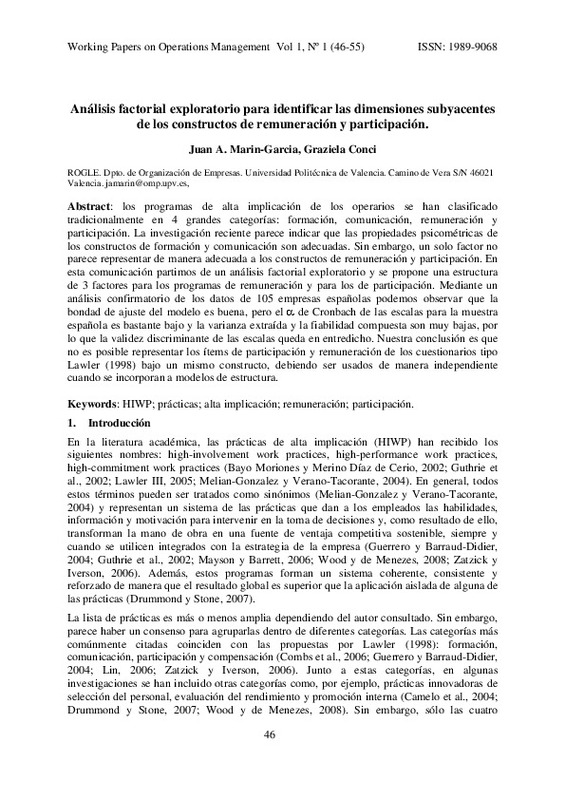Benson, G. S., Young, S. M., & Lawler III, E. E. (2006). High-involvement work practices and analysts’ forecasts of corporate earnings. Human Resource Management, 45(4), 519-537. doi:10.1002/hrm.20130
Bentler, P. M. (2002). EQS 6 Structural Equations Program Manual. Multivariate Software, Inc.
Camelo, C., Martín, F., Romero, P. M., & Valle, R. (2004). Human resources management in Spain: is it possible to speak of a typical model? The International Journal of Human Resource Management, 15(6), 935-958. doi:10.1080/09585190410001677250
[+]
Benson, G. S., Young, S. M., & Lawler III, E. E. (2006). High-involvement work practices and analysts’ forecasts of corporate earnings. Human Resource Management, 45(4), 519-537. doi:10.1002/hrm.20130
Bentler, P. M. (2002). EQS 6 Structural Equations Program Manual. Multivariate Software, Inc.
Camelo, C., Martín, F., Romero, P. M., & Valle, R. (2004). Human resources management in Spain: is it possible to speak of a typical model? The International Journal of Human Resource Management, 15(6), 935-958. doi:10.1080/09585190410001677250
COMBS, J., LIU, Y., HALL, A., & KETCHEN, D. (2006). HOW MUCH DO HIGH-PERFORMANCE WORK PRACTICES MATTER? A META-ANALYSIS OF THEIR EFFECTS ON ORGANIZATIONAL PERFORMANCE. Personnel Psychology, 59(3), 501-528. doi:10.1111/j.1744-6570.2006.00045.x
Coye, R. W., & Belohlav, J. A. (1995). An Exploratory Analysis of Employee Participation. Group & Organization Management, 20(1), 4-17. doi:10.1177/1059601195201002
Drehmer, D. E., Belohlav, J. A., & Coye, R. W. (2000). An Exploration of Employee Participation Using a Scaling Approach. Group & Organization Management, 25(4), 397-418. doi:10.1177/1059601100254005
Drummond, I., & Stone, I. (2007). Exploring the potential of high performance work systems in SMEs. Employee Relations, 29(2), 192-207. doi:10.1108/01425450710720011
Guerrero, S., & Barraud-Didier, V. (2004). High-involvement practices and performance of French firms. The International Journal of Human Resource Management, 15(8), 1408-1423. doi:10.1080/0958519042000258002
Guthrie, J. P., Spell, C. S., & Nyamori, R. O. (2002). Correlates and consequences of high involvement work practices: the role of competitive strategy. The International Journal of Human Resource Management, 13(1), 183-197. doi:10.1080/09585190110085071
Hair, J. F.; Anderson, R. E.; Tatham, R. L.; Black, W. C. (1995). Multivariate data analysis, 4º. Prentice Hall.
Hair, J. F.; Anderson, R. E.; Tatham, R. L.; Black, W. C. (1999). Análisis de datos multivariante, 4º. Prentice Hall.
Lawler, E. E. (2005). From human resource management to organizational effectiveness. Human Resource Management, 44(2), 165-169. doi:10.1002/hrm.20059
Lawler III, E. E.; Mohrman, S.; Ledford, G. (1998). Strategies for high performance organizations: employee involvement, TQM, and reengineering programs in fortune 1000 coporations. Jossey-Bass.
Lin, W.-B. (2006). The exploration of employee involvement model. Expert Systems with Applications, 31(1), 69-82. doi:10.1016/j.eswa.2005.09.035
Marin-Garcia, J. A.; Bonavía Martín, T.; Miralles Insa, C. (2008). The use of employee participation in the USA and Spanish companies. International Journal of Management Science and Engineering Management, Vol. 3, nº. 1, pp. 71-80.
Marin-Garcia, J. A., & Conci, G. (2009). Exploratory study of high involvement work practices: Identification of the dimensions and proposal of questionnaire to measure the degree of use in the company. Intangible Capital, 5(3). doi:10.3926/ic.2009.v5n3.p278-300
Mayson, S., & Barrett, R. (2006). The ‘science’ and ‘practice’ of HRM in small firms. Human Resource Management Review, 16(4), 447-455. doi:10.1016/j.hrmr.2006.08.002
González, S. M., & Tacorante, D. V. (2004). A new approach to the best practices debate: are best practices applied to all employees in the same way? The International Journal of Human Resource Management, 15(1), 56-75. doi:10.1080/098519032000157339
Sila, I. (2006). Examining the effects of contextual factors on TQM and performance through the lens of organizational theories: An empirical study. Journal of Operations Management, 25(1), 83-109. doi:10.1016/j.jom.2006.02.003
Spreitzer, G. M. (1995). PSYCHOLOGICAL, EMPOWERMENT IN THE WORKPLACE: DIMENSIONS, MEASUREMENT AND VALIDATION. Academy of Management Journal, 38(5), 1442-1465. doi:10.2307/256865
Tarí, J. J., Molina, J. F., & Castejón, J. L. (2007). The relationship between quality management practices and their effects on quality outcomes. European Journal of Operational Research, 183(2), 483-501. doi:10.1016/j.ejor.2006.10.016
Ullman, J. B.; Bentler, P. M. (2004). Structural Equation Modeling, en M. Hardy y A. Bryman (dir), Handbook of Data Analysis, pp. 431-458. SAGE
Wood, S., & de Menezes, L. M. (2008). Comparing perspectives on high involvement management and organizational performance across the British economy. The International Journal of Human Resource Management, 19(4), 639-683. doi:10.1080/09585190801953673
Yu, C.-S.; Finegold, D.; Lawler III, E. E.; Cochran, D. S. (2000). Does cultural fit matter? The adoption and efectiveness of the employee involvement practices in China and the United States. Current Topics on Management, Vol. 5.
Zatzick, C. D., & Iverson, R. D. (2006). High-Involvement Management and Workforce Reduction: Competitive Advantage or Disadvantage? Academy of Management Journal, 49(5), 999-1015. doi:10.5465/amj.2006.22798180
[-]









